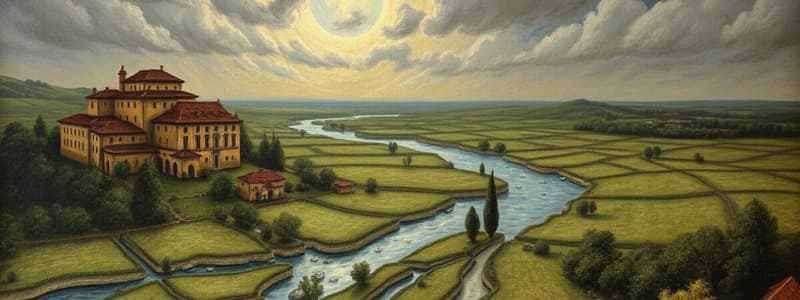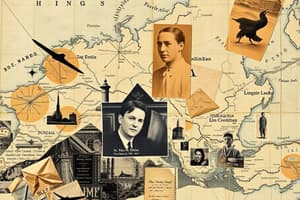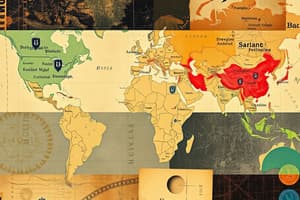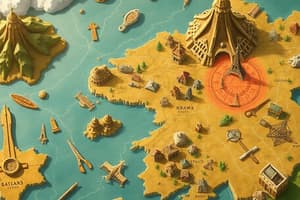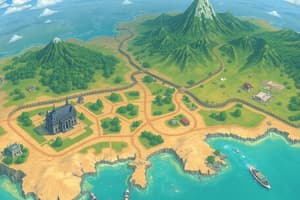Podcast
Questions and Answers
A map is a three-dimensional graphical representation of the Earth's surface.
A map is a three-dimensional graphical representation of the Earth's surface.
False (B)
The scale on a map explains the ratio of distances represented on the map to actual distances on the ground.
The scale on a map explains the ratio of distances represented on the map to actual distances on the ground.
True (A)
The North line in a map is used to indicate the South direction.
The North line in a map is used to indicate the South direction.
False (B)
Maps can provide more detailed topographical information than a globe.
Maps can provide more detailed topographical information than a globe.
A map's legend lists the symbols used on the map along with their meanings.
A map's legend lists the symbols used on the map along with their meanings.
Maps cannot be easily folded, making them less portable.
Maps cannot be easily folded, making them less portable.
Latitude lines are horizontal and increase in value as you travel south on the map.
Latitude lines are horizontal and increase in value as you travel south on the map.
Maps are used exclusively for navigation and do not have any administrative purposes.
Maps are used exclusively for navigation and do not have any administrative purposes.
A map is a graphical representation of the Earth on a flat surface.
A map is a graphical representation of the Earth on a flat surface.
A sketch map always includes precise scale measurements.
A sketch map always includes precise scale measurements.
A plan is a carefully and scientifically drawn image of an area that can depict any detail.
A plan is a carefully and scientifically drawn image of an area that can depict any detail.
Globe representations of the Earth can distort the shapes and sizes of continents.
Globe representations of the Earth can distort the shapes and sizes of continents.
The scale of a map helps to understand the relationship between map distances and real-life distances.
The scale of a map helps to understand the relationship between map distances and real-life distances.
A representative fraction scale is typically expressed with the denominator being much smaller than the numerator.
A representative fraction scale is typically expressed with the denominator being much smaller than the numerator.
A small-scale map can show a large area with limited detail.
A small-scale map can show a large area with limited detail.
Vertical scales are often used to measure large distances on maps.
Vertical scales are often used to measure large distances on maps.
Cardinal directions include North, East, South, and West.
Cardinal directions include North, East, South, and West.
Diagonal scales are primarily used for measuring large distances.
Diagonal scales are primarily used for measuring large distances.
The midpoint direction between North and East is called southeast.
The midpoint direction between North and East is called southeast.
Maps provide less detail than plans but can depict larger areas.
Maps provide less detail than plans but can depict larger areas.
The scale of a map can only be expressed as a ratio.
The scale of a map can only be expressed as a ratio.
All features on a map are represented by conventional symbols.
All features on a map are represented by conventional symbols.
Conventional symbols on maps are universally accepted and used, helping to eliminate confusion.
Conventional symbols on maps are universally accepted and used, helping to eliminate confusion.
Line symbols on a map represent areas such as forests and cultivation.
Line symbols on a map represent areas such as forests and cultivation.
A tributary is a small river that flows into a larger river.
A tributary is a small river that flows into a larger river.
Deltas are formed at the source of rivers where they begin their journey.
Deltas are formed at the source of rivers where they begin their journey.
Anticlines are formed from compressed layers of rocks, resulting in upfolds.
Anticlines are formed from compressed layers of rocks, resulting in upfolds.
Distributaries rejoin the main river after branching off.
Distributaries rejoin the main river after branching off.
Meanders are formed when rivers flow through mountainous regions, resulting in narrow bends.
Meanders are formed when rivers flow through mountainous regions, resulting in narrow bends.
Block mountains are created through the uplift of a central block between two faults.
Block mountains are created through the uplift of a central block between two faults.
The crest of a fold in the Earth's crust is referred to as a syncline.
The crest of a fold in the Earth's crust is referred to as a syncline.
Blue is used to represent water bodies on maps.
Blue is used to represent water bodies on maps.
Flashcards are hidden until you start studying
Study Notes
Maps Overview
- Maps are two-dimensional representations of the Earth's surface, showing land and water features.
- They simplify geographical information, allowing for understanding of distances, directions, and the shapes of countries.
Elements of a Map
- Title: Identifies the purpose of the map, usually found at the top.
- Legend: Explains symbols used, which can include shapes, colors, and lines.
- Scale: Shows the ratio of map distances to actual ground distances (e.g., 1 cm on the map equals 100 km).
- North Line: Indicates the North direction for orienting the map.
- Grid: Comprises horizontal (latitudes) and vertical (longitudes) lines, facilitating exact location pinpointing.
Advantages of Maps
- Portable, allowing for easy transport and use.
- Detailed representation of urban layouts and various geographical areas.
- More informative than globes, particularly for specific topographical information.
- Easily updated to reflect changes in physical or political landscapes.
- Useful for various professionals like sailors, pilots, engineers, and urban planners.
- Employed by governments for administrative, planning, and defense.
Importance of Maps
- Represent the real world on a reduced scale, aiding in navigation and travel.
- Organize geographical data, illustrating climate, agricultural products, and population dynamics.
Comparison of Maps, Sketches, Plans, and Globes
- Map: Scientific and scaled representation of Earth; shows details using symbols.
- Sketch: Rough, freehand representation highlighting main features without a scale.
- Plan: Detailed drawing of small areas with precise measurements, always using a large scale.
- Globe: Three-dimensional, accurate representation of the Earth’s shape and geography.
Differences Between Maps and Sketches
- Maps are scaled and scientifically drawn; sketches lack scale and precision.
Differences Between Maps and Plans
- Maps offer a broader view of regions without extensive detail; plans detail small areas comprehensively.
Differences Between Maps and Globes
- Maps can display all locations simultaneously but may distort shapes; globes accurately depict Earth's physical form.
Understanding Scale
- Scale conveys the relationship between map distance and actual ground distance.
- Displayed in various formats: statement scales, representative fractions, and linear scales.
- Example scale: 1:25,000 means 1 cm on a map corresponds to 25,000 cm in reality.
Types of Map Scales
- Small-Scale Maps: Cover large areas, showing limited detail (e.g., world maps).
- Large-Scale Maps: Focus on small areas, providing extensive details (e.g., city maps).
Directions and Cardinal Points
- Four main cardinal directions: North, East, South, West, with intermediate directions like Northeast and Southeast aiding navigation.
Conventional Symbols in Maps
- Standardized symbols allow easy interpretation of features such as roads, buildings, and water bodies.
- Point symbols for locations, line symbols for paths, and area symbols for land types are commonly used.
Representation of Geographical Features
- Diagrams illustrate features like rivers, meanders, tributaries, distributaries, and deltas.
- Meanders: Wide loops formed by slow-flowing rivers in flat areas.
- Tributaries: Smaller rivers flowing into larger rivers; distributaries diverge from a main river.
- Delta: A landform at a river's mouth made of silt deposits.
Geological Features
- Anticlines and Synclines: Folds in Earth's crust created through compression.
- Block Mountains: Formed by geological faults; rift valleys occur when central blocks subside.
- Arch: A curved structure, typically supporting weight above it.
These notes encapsulate the essential points regarding maps, their components, differences with other representations, and their vital role in understanding geographical data.
Studying That Suits You
Use AI to generate personalized quizzes and flashcards to suit your learning preferences.
